Ethical Dilemma
VerifiedAdded on 2023/06/10
|15
|4208
|211
AI Summary
This article discusses an ethical dilemma faced by an employee at a workplace and the importance of ethical decision making. It also includes a portfolio of evidence related to ethical leadership and a seminar case.
Contribute Materials
Your contribution can guide someone’s learning journey. Share your
documents today.
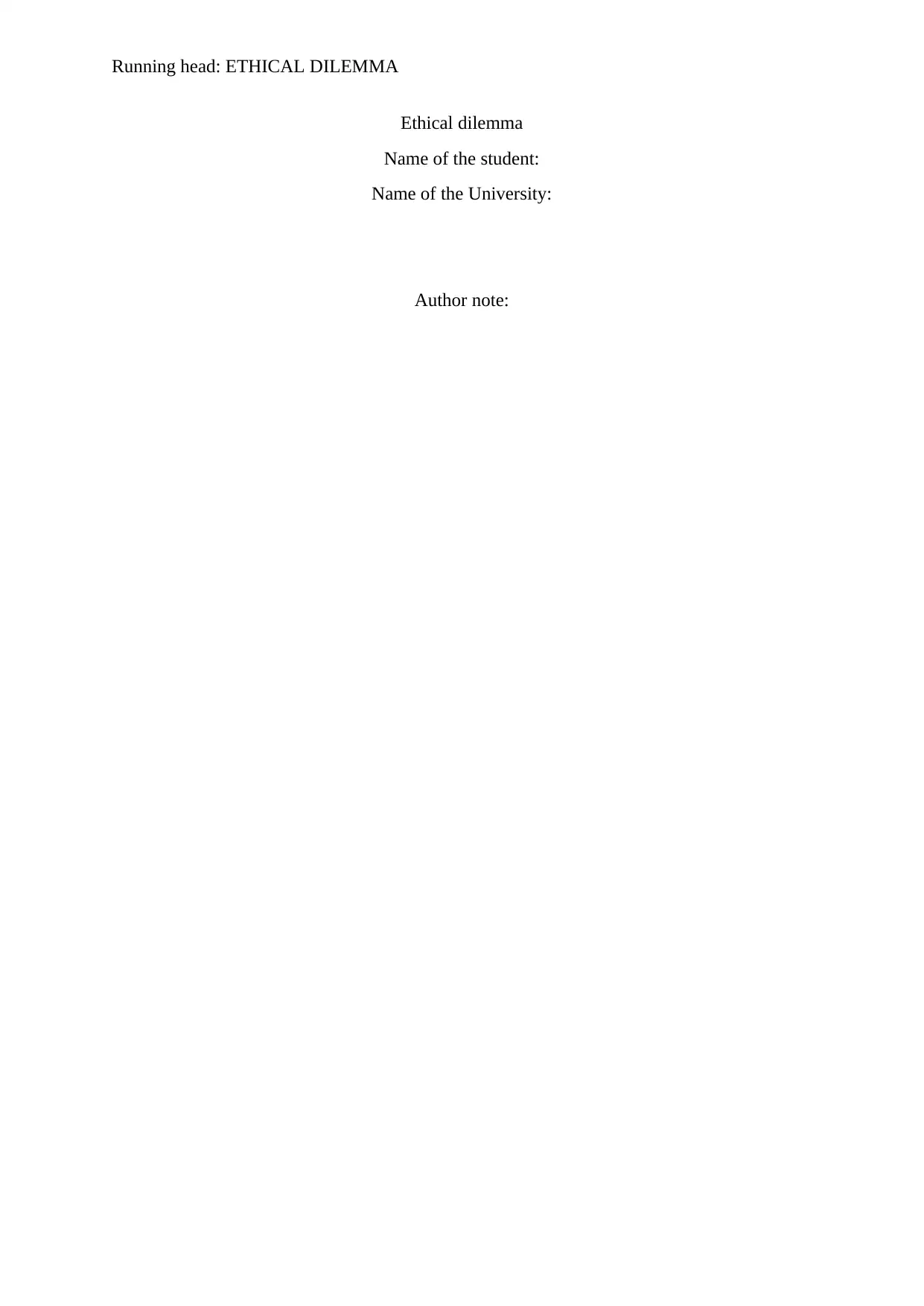
Running head: ETHICAL DILEMMA
Ethical dilemma
Name of the student:
Name of the University:
Author note:
Ethical dilemma
Name of the student:
Name of the University:
Author note:
Secure Best Marks with AI Grader
Need help grading? Try our AI Grader for instant feedback on your assignments.
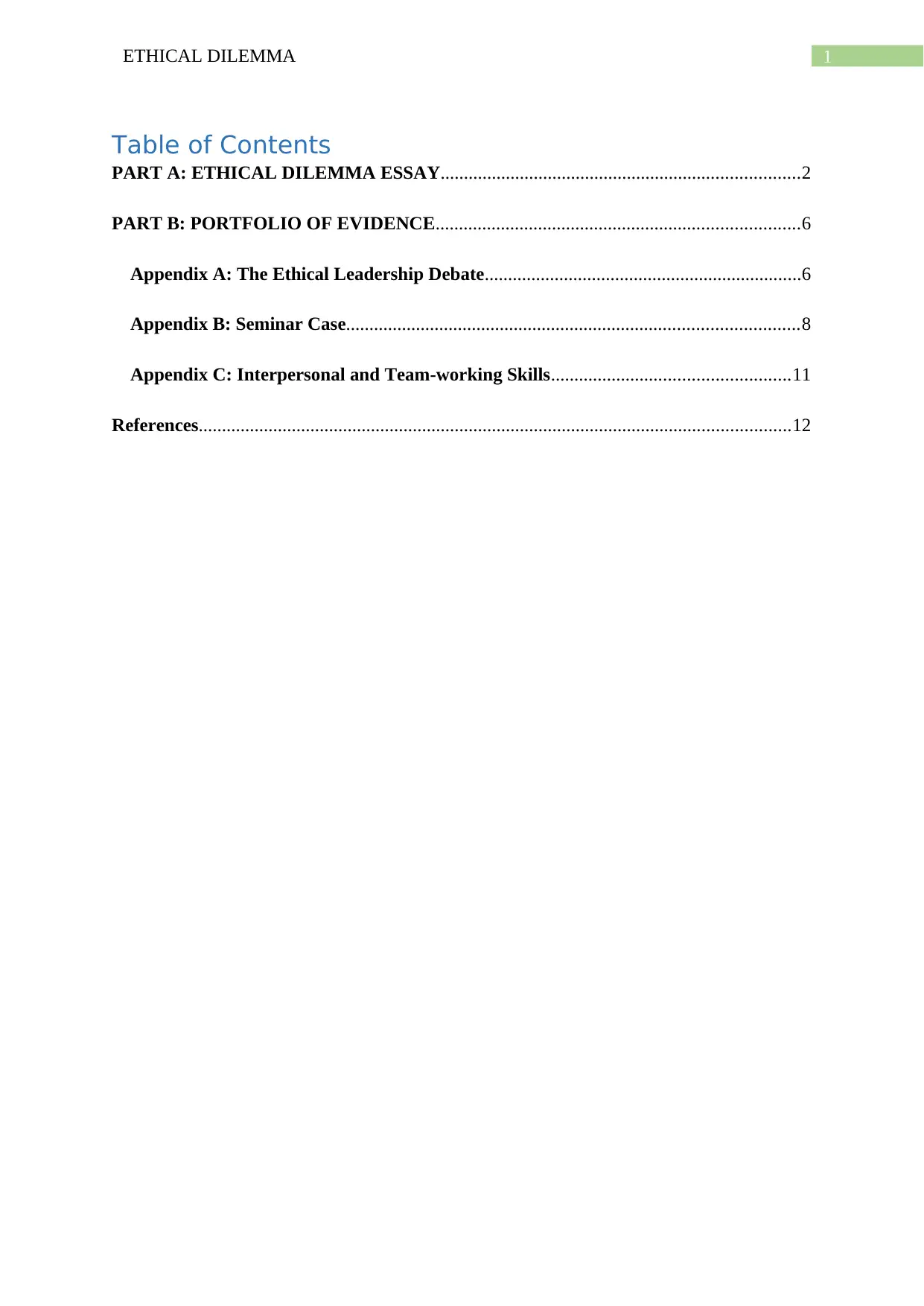
1ETHICAL DILEMMA
Table of Contents
PART A: ETHICAL DILEMMA ESSAY.............................................................................2
PART B: PORTFOLIO OF EVIDENCE..............................................................................6
Appendix A: The Ethical Leadership Debate....................................................................6
Appendix B: Seminar Case.................................................................................................8
Appendix C: Interpersonal and Team-working Skills...................................................11
References...............................................................................................................................12
Table of Contents
PART A: ETHICAL DILEMMA ESSAY.............................................................................2
PART B: PORTFOLIO OF EVIDENCE..............................................................................6
Appendix A: The Ethical Leadership Debate....................................................................6
Appendix B: Seminar Case.................................................................................................8
Appendix C: Interpersonal and Team-working Skills...................................................11
References...............................................................................................................................12

2ETHICAL DILEMMA
PART A: ETHICAL DILEMMA ESSAY
Every individual possess a distinctive moral responsibility and principles that
influence his or her actions and behaviour. The conflict that arises in these personal views
and opinion is what we know as a dilemma. I have been an employee of company X since
past 5 years. The company is a small and medium-sized enterprise. Lately, I have faced a
situation at my workplace that have put me in an ethical dilemma. The manager of our
company Madam A, seem to have favoured a particular employee in our company named Mr
B. Now we all know that favouritism is a form of unethical act, which is not acceptable at any
workplace. However, Madam A has offered Mr B with increment who coincidently is the son
of her good friend. Mr B works as a junior subordinate in our company and until now have
not been a significant contributor for the company, nonetheless, was privileged with an
increment. Such action is a clear violation of professional ethics and I am not willing to
accept it.
The company will have a negative impact as a result of favouritism. The head of
management is responsible for offering promotions and assign an employee with
responsibilities based on his or her capabilities. However, when these are compromised and
the management ignores employee value then the company shall cease itself to attract skilled
and qualified employees. The company is bound to be damaged eventually as it compromises
with qualified employees and practice favouritism instead. Employee favouritism can also be
termed as employee cancer since it creates an unjust environment in the workplace, which
eventually generates conflict among employees and thus, downgrading the company’s
position and reputation (Bute, 2011). A sickness as such must be uprooted completely then
only it is possible for it to be cured. Therefore, I am in a situation of ethical dilemma to pick
an option to either report this unjust practice of favouritism to the Director or endure this
situation silently as my other colleagues do. After a lot of thought, I decided to go for the
PART A: ETHICAL DILEMMA ESSAY
Every individual possess a distinctive moral responsibility and principles that
influence his or her actions and behaviour. The conflict that arises in these personal views
and opinion is what we know as a dilemma. I have been an employee of company X since
past 5 years. The company is a small and medium-sized enterprise. Lately, I have faced a
situation at my workplace that have put me in an ethical dilemma. The manager of our
company Madam A, seem to have favoured a particular employee in our company named Mr
B. Now we all know that favouritism is a form of unethical act, which is not acceptable at any
workplace. However, Madam A has offered Mr B with increment who coincidently is the son
of her good friend. Mr B works as a junior subordinate in our company and until now have
not been a significant contributor for the company, nonetheless, was privileged with an
increment. Such action is a clear violation of professional ethics and I am not willing to
accept it.
The company will have a negative impact as a result of favouritism. The head of
management is responsible for offering promotions and assign an employee with
responsibilities based on his or her capabilities. However, when these are compromised and
the management ignores employee value then the company shall cease itself to attract skilled
and qualified employees. The company is bound to be damaged eventually as it compromises
with qualified employees and practice favouritism instead. Employee favouritism can also be
termed as employee cancer since it creates an unjust environment in the workplace, which
eventually generates conflict among employees and thus, downgrading the company’s
position and reputation (Bute, 2011). A sickness as such must be uprooted completely then
only it is possible for it to be cured. Therefore, I am in a situation of ethical dilemma to pick
an option to either report this unjust practice of favouritism to the Director or endure this
situation silently as my other colleagues do. After a lot of thought, I decided to go for the

3ETHICAL DILEMMA
former option. The Director of the company was co-operative enough and listened to the
entire scenario. He decided to investigate the matter and take necessary actions against it.
One of the characteristics of an ethical issue is moral intensity, which influences the
ethical level of a decision (Jones, 1991). It is less likely for an individual to take unethical
decision when there is high level of moral intensity of an issue (Coram et al., 2008). In order
to increase the chances of healthy competition among employees the authorities of the
company must be reported with such unethical practice of favouritism then only such practice
can be eliminated from a workplace. In reference to the social consensus, the amount of
support that I received from my peers in exposing the unjustified practice of favouritism at
our company to our Director increased my moral intensity. Adding to this, our Director
already knew about this ill practice of favouritism in our company and he did not delay a
minute in initiating investigation about this reported matter, as it would hamper company’s
position as well as reputation.
The shorter the amount of time between the investigation procedure and its resulting
outcomes the greater shall be temporal immediacy and moral intensity (Jones, 1991). The
resulting outcome after the completion of investigation will bring in immediate amendments
in the employees welfare of the company. The above-mentioned scenario includes the
managerial Head Madam A, the Director of the Company including the employees Mr B, me
and my other colleagues therefore, the level of proximity is high as every individual belongs
to the same organisation. One of the components of moral intensity is concentration of effect,
which includes the opposite function of the total number of people being affected by the
ethical act (Jones, 1991). The action adopted by me brought positive impact in employees’
morale as this fixed the issue of favouritism and brought in a more stable rewarding system.
Hence, the company’s reputation was also regained by discarding the unjust act of
favouritism from the workplace.
former option. The Director of the company was co-operative enough and listened to the
entire scenario. He decided to investigate the matter and take necessary actions against it.
One of the characteristics of an ethical issue is moral intensity, which influences the
ethical level of a decision (Jones, 1991). It is less likely for an individual to take unethical
decision when there is high level of moral intensity of an issue (Coram et al., 2008). In order
to increase the chances of healthy competition among employees the authorities of the
company must be reported with such unethical practice of favouritism then only such practice
can be eliminated from a workplace. In reference to the social consensus, the amount of
support that I received from my peers in exposing the unjustified practice of favouritism at
our company to our Director increased my moral intensity. Adding to this, our Director
already knew about this ill practice of favouritism in our company and he did not delay a
minute in initiating investigation about this reported matter, as it would hamper company’s
position as well as reputation.
The shorter the amount of time between the investigation procedure and its resulting
outcomes the greater shall be temporal immediacy and moral intensity (Jones, 1991). The
resulting outcome after the completion of investigation will bring in immediate amendments
in the employees welfare of the company. The above-mentioned scenario includes the
managerial Head Madam A, the Director of the Company including the employees Mr B, me
and my other colleagues therefore, the level of proximity is high as every individual belongs
to the same organisation. One of the components of moral intensity is concentration of effect,
which includes the opposite function of the total number of people being affected by the
ethical act (Jones, 1991). The action adopted by me brought positive impact in employees’
morale as this fixed the issue of favouritism and brought in a more stable rewarding system.
Hence, the company’s reputation was also regained by discarding the unjust act of
favouritism from the workplace.
Secure Best Marks with AI Grader
Need help grading? Try our AI Grader for instant feedback on your assignments.
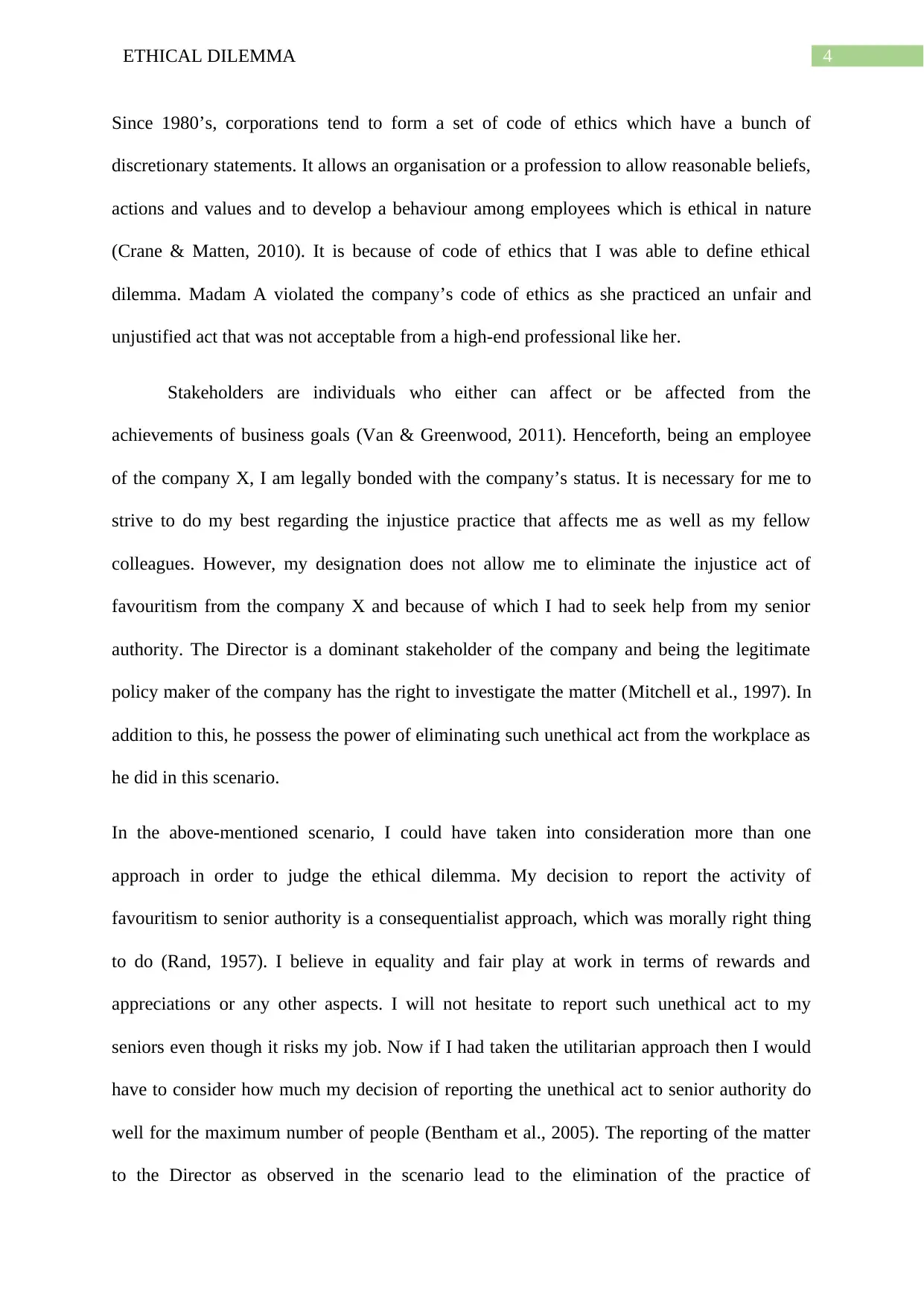
4ETHICAL DILEMMA
Since 1980’s, corporations tend to form a set of code of ethics which have a bunch of
discretionary statements. It allows an organisation or a profession to allow reasonable beliefs,
actions and values and to develop a behaviour among employees which is ethical in nature
(Crane & Matten, 2010). It is because of code of ethics that I was able to define ethical
dilemma. Madam A violated the company’s code of ethics as she practiced an unfair and
unjustified act that was not acceptable from a high-end professional like her.
Stakeholders are individuals who either can affect or be affected from the
achievements of business goals (Van & Greenwood, 2011). Henceforth, being an employee
of the company X, I am legally bonded with the company’s status. It is necessary for me to
strive to do my best regarding the injustice practice that affects me as well as my fellow
colleagues. However, my designation does not allow me to eliminate the injustice act of
favouritism from the company X and because of which I had to seek help from my senior
authority. The Director is a dominant stakeholder of the company and being the legitimate
policy maker of the company has the right to investigate the matter (Mitchell et al., 1997). In
addition to this, he possess the power of eliminating such unethical act from the workplace as
he did in this scenario.
In the above-mentioned scenario, I could have taken into consideration more than one
approach in order to judge the ethical dilemma. My decision to report the activity of
favouritism to senior authority is a consequentialist approach, which was morally right thing
to do (Rand, 1957). I believe in equality and fair play at work in terms of rewards and
appreciations or any other aspects. I will not hesitate to report such unethical act to my
seniors even though it risks my job. Now if I had taken the utilitarian approach then I would
have to consider how much my decision of reporting the unethical act to senior authority do
well for the maximum number of people (Bentham et al., 2005). The reporting of the matter
to the Director as observed in the scenario lead to the elimination of the practice of
Since 1980’s, corporations tend to form a set of code of ethics which have a bunch of
discretionary statements. It allows an organisation or a profession to allow reasonable beliefs,
actions and values and to develop a behaviour among employees which is ethical in nature
(Crane & Matten, 2010). It is because of code of ethics that I was able to define ethical
dilemma. Madam A violated the company’s code of ethics as she practiced an unfair and
unjustified act that was not acceptable from a high-end professional like her.
Stakeholders are individuals who either can affect or be affected from the
achievements of business goals (Van & Greenwood, 2011). Henceforth, being an employee
of the company X, I am legally bonded with the company’s status. It is necessary for me to
strive to do my best regarding the injustice practice that affects me as well as my fellow
colleagues. However, my designation does not allow me to eliminate the injustice act of
favouritism from the company X and because of which I had to seek help from my senior
authority. The Director is a dominant stakeholder of the company and being the legitimate
policy maker of the company has the right to investigate the matter (Mitchell et al., 1997). In
addition to this, he possess the power of eliminating such unethical act from the workplace as
he did in this scenario.
In the above-mentioned scenario, I could have taken into consideration more than one
approach in order to judge the ethical dilemma. My decision to report the activity of
favouritism to senior authority is a consequentialist approach, which was morally right thing
to do (Rand, 1957). I believe in equality and fair play at work in terms of rewards and
appreciations or any other aspects. I will not hesitate to report such unethical act to my
seniors even though it risks my job. Now if I had taken the utilitarian approach then I would
have to consider how much my decision of reporting the unethical act to senior authority do
well for the maximum number of people (Bentham et al., 2005). The reporting of the matter
to the Director as observed in the scenario lead to the elimination of the practice of
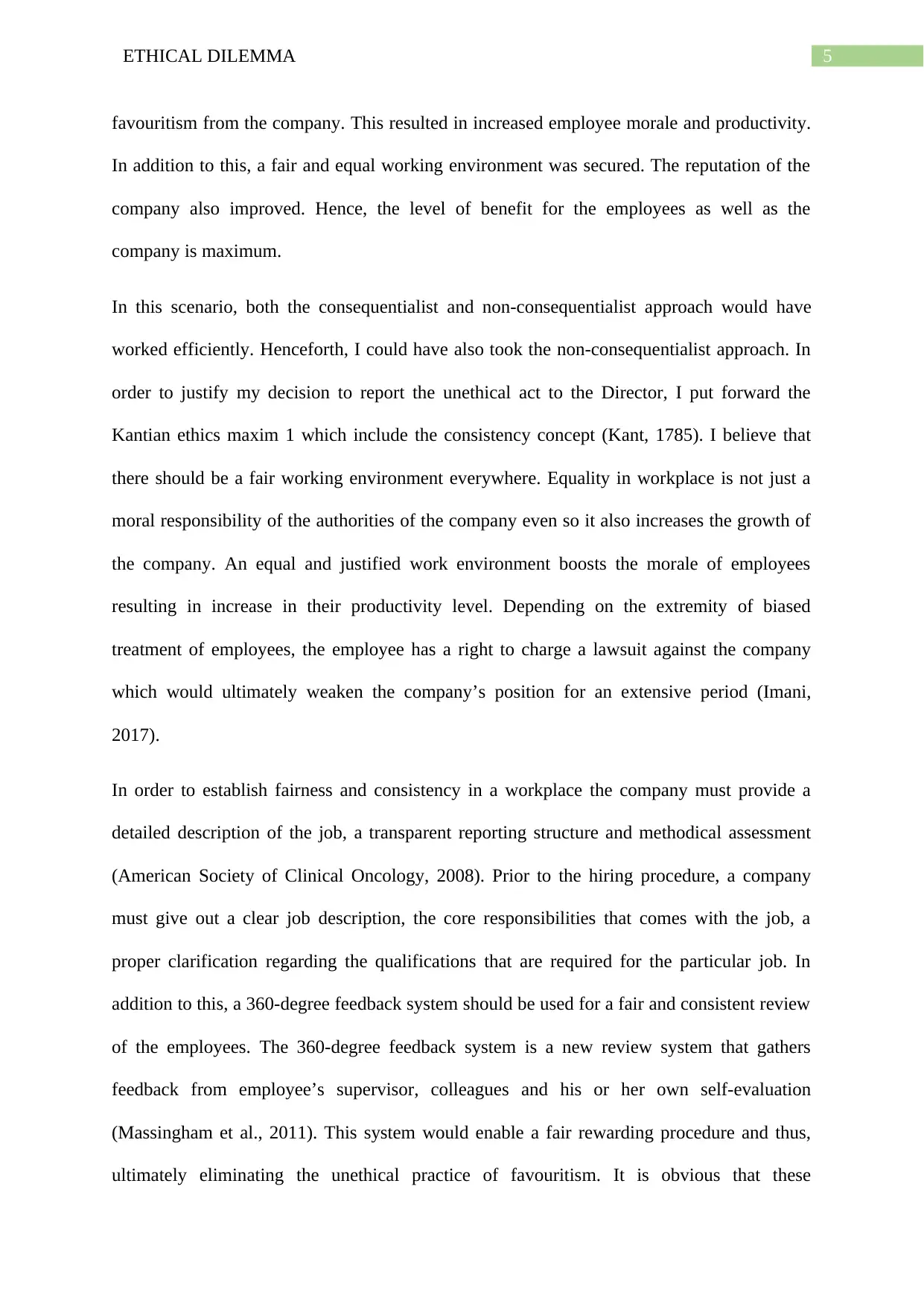
5ETHICAL DILEMMA
favouritism from the company. This resulted in increased employee morale and productivity.
In addition to this, a fair and equal working environment was secured. The reputation of the
company also improved. Hence, the level of benefit for the employees as well as the
company is maximum.
In this scenario, both the consequentialist and non-consequentialist approach would have
worked efficiently. Henceforth, I could have also took the non-consequentialist approach. In
order to justify my decision to report the unethical act to the Director, I put forward the
Kantian ethics maxim 1 which include the consistency concept (Kant, 1785). I believe that
there should be a fair working environment everywhere. Equality in workplace is not just a
moral responsibility of the authorities of the company even so it also increases the growth of
the company. An equal and justified work environment boosts the morale of employees
resulting in increase in their productivity level. Depending on the extremity of biased
treatment of employees, the employee has a right to charge a lawsuit against the company
which would ultimately weaken the company’s position for an extensive period (Imani,
2017).
In order to establish fairness and consistency in a workplace the company must provide a
detailed description of the job, a transparent reporting structure and methodical assessment
(American Society of Clinical Oncology, 2008). Prior to the hiring procedure, a company
must give out a clear job description, the core responsibilities that comes with the job, a
proper clarification regarding the qualifications that are required for the particular job. In
addition to this, a 360-degree feedback system should be used for a fair and consistent review
of the employees. The 360-degree feedback system is a new review system that gathers
feedback from employee’s supervisor, colleagues and his or her own self-evaluation
(Massingham et al., 2011). This system would enable a fair rewarding procedure and thus,
ultimately eliminating the unethical practice of favouritism. It is obvious that these
favouritism from the company. This resulted in increased employee morale and productivity.
In addition to this, a fair and equal working environment was secured. The reputation of the
company also improved. Hence, the level of benefit for the employees as well as the
company is maximum.
In this scenario, both the consequentialist and non-consequentialist approach would have
worked efficiently. Henceforth, I could have also took the non-consequentialist approach. In
order to justify my decision to report the unethical act to the Director, I put forward the
Kantian ethics maxim 1 which include the consistency concept (Kant, 1785). I believe that
there should be a fair working environment everywhere. Equality in workplace is not just a
moral responsibility of the authorities of the company even so it also increases the growth of
the company. An equal and justified work environment boosts the morale of employees
resulting in increase in their productivity level. Depending on the extremity of biased
treatment of employees, the employee has a right to charge a lawsuit against the company
which would ultimately weaken the company’s position for an extensive period (Imani,
2017).
In order to establish fairness and consistency in a workplace the company must provide a
detailed description of the job, a transparent reporting structure and methodical assessment
(American Society of Clinical Oncology, 2008). Prior to the hiring procedure, a company
must give out a clear job description, the core responsibilities that comes with the job, a
proper clarification regarding the qualifications that are required for the particular job. In
addition to this, a 360-degree feedback system should be used for a fair and consistent review
of the employees. The 360-degree feedback system is a new review system that gathers
feedback from employee’s supervisor, colleagues and his or her own self-evaluation
(Massingham et al., 2011). This system would enable a fair rewarding procedure and thus,
ultimately eliminating the unethical practice of favouritism. It is obvious that these
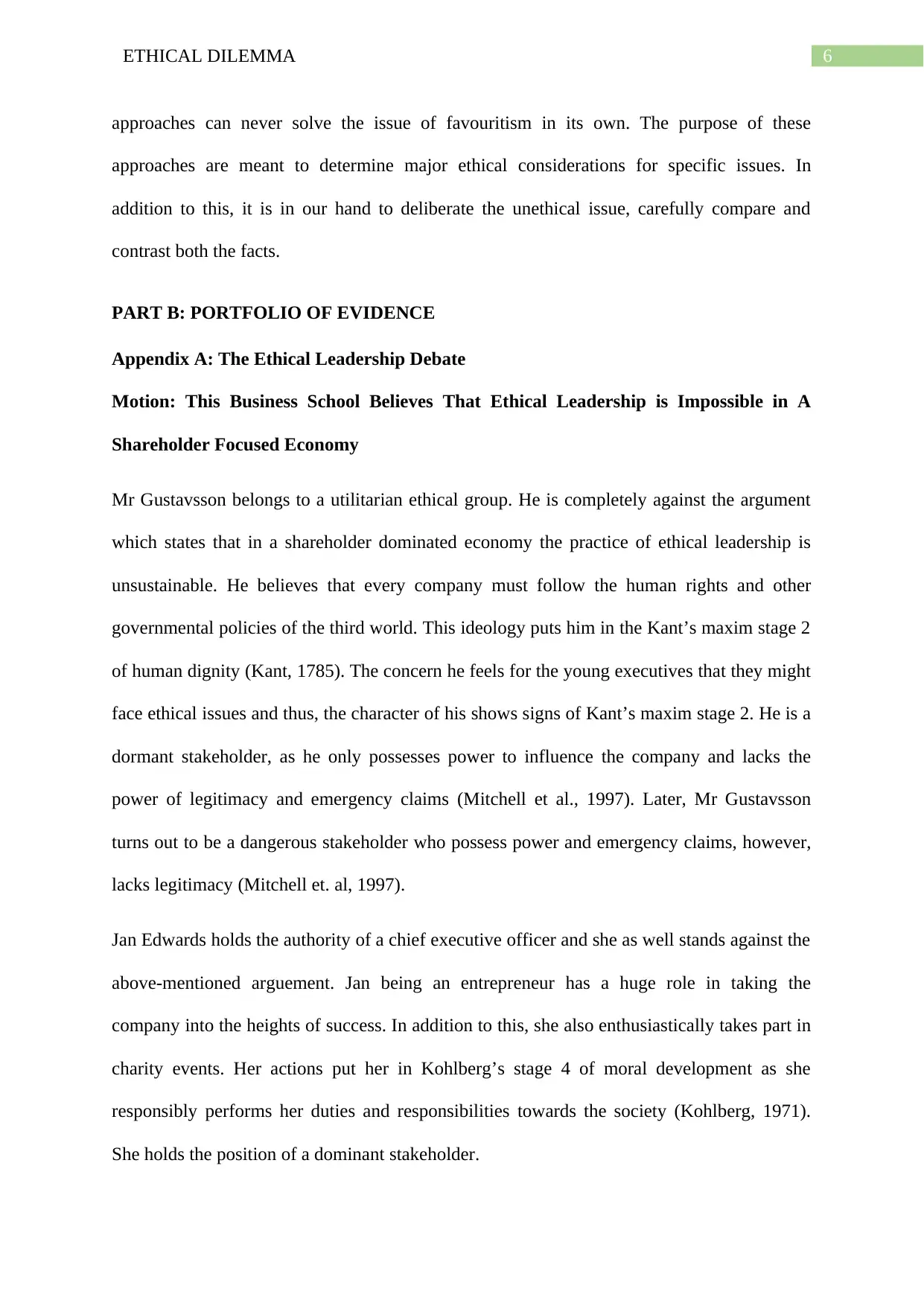
6ETHICAL DILEMMA
approaches can never solve the issue of favouritism in its own. The purpose of these
approaches are meant to determine major ethical considerations for specific issues. In
addition to this, it is in our hand to deliberate the unethical issue, carefully compare and
contrast both the facts.
PART B: PORTFOLIO OF EVIDENCE
Appendix A: The Ethical Leadership Debate
Motion: This Business School Believes That Ethical Leadership is Impossible in A
Shareholder Focused Economy
Mr Gustavsson belongs to a utilitarian ethical group. He is completely against the argument
which states that in a shareholder dominated economy the practice of ethical leadership is
unsustainable. He believes that every company must follow the human rights and other
governmental policies of the third world. This ideology puts him in the Kant’s maxim stage 2
of human dignity (Kant, 1785). The concern he feels for the young executives that they might
face ethical issues and thus, the character of his shows signs of Kant’s maxim stage 2. He is a
dormant stakeholder, as he only possesses power to influence the company and lacks the
power of legitimacy and emergency claims (Mitchell et al., 1997). Later, Mr Gustavsson
turns out to be a dangerous stakeholder who possess power and emergency claims, however,
lacks legitimacy (Mitchell et. al, 1997).
Jan Edwards holds the authority of a chief executive officer and she as well stands against the
above-mentioned arguement. Jan being an entrepreneur has a huge role in taking the
company into the heights of success. In addition to this, she also enthusiastically takes part in
charity events. Her actions put her in Kohlberg’s stage 4 of moral development as she
responsibly performs her duties and responsibilities towards the society (Kohlberg, 1971).
She holds the position of a dominant stakeholder.
approaches can never solve the issue of favouritism in its own. The purpose of these
approaches are meant to determine major ethical considerations for specific issues. In
addition to this, it is in our hand to deliberate the unethical issue, carefully compare and
contrast both the facts.
PART B: PORTFOLIO OF EVIDENCE
Appendix A: The Ethical Leadership Debate
Motion: This Business School Believes That Ethical Leadership is Impossible in A
Shareholder Focused Economy
Mr Gustavsson belongs to a utilitarian ethical group. He is completely against the argument
which states that in a shareholder dominated economy the practice of ethical leadership is
unsustainable. He believes that every company must follow the human rights and other
governmental policies of the third world. This ideology puts him in the Kant’s maxim stage 2
of human dignity (Kant, 1785). The concern he feels for the young executives that they might
face ethical issues and thus, the character of his shows signs of Kant’s maxim stage 2. He is a
dormant stakeholder, as he only possesses power to influence the company and lacks the
power of legitimacy and emergency claims (Mitchell et al., 1997). Later, Mr Gustavsson
turns out to be a dangerous stakeholder who possess power and emergency claims, however,
lacks legitimacy (Mitchell et. al, 1997).
Jan Edwards holds the authority of a chief executive officer and she as well stands against the
above-mentioned arguement. Jan being an entrepreneur has a huge role in taking the
company into the heights of success. In addition to this, she also enthusiastically takes part in
charity events. Her actions put her in Kohlberg’s stage 4 of moral development as she
responsibly performs her duties and responsibilities towards the society (Kohlberg, 1971).
She holds the position of a dominant stakeholder.
Paraphrase This Document
Need a fresh take? Get an instant paraphrase of this document with our AI Paraphraser
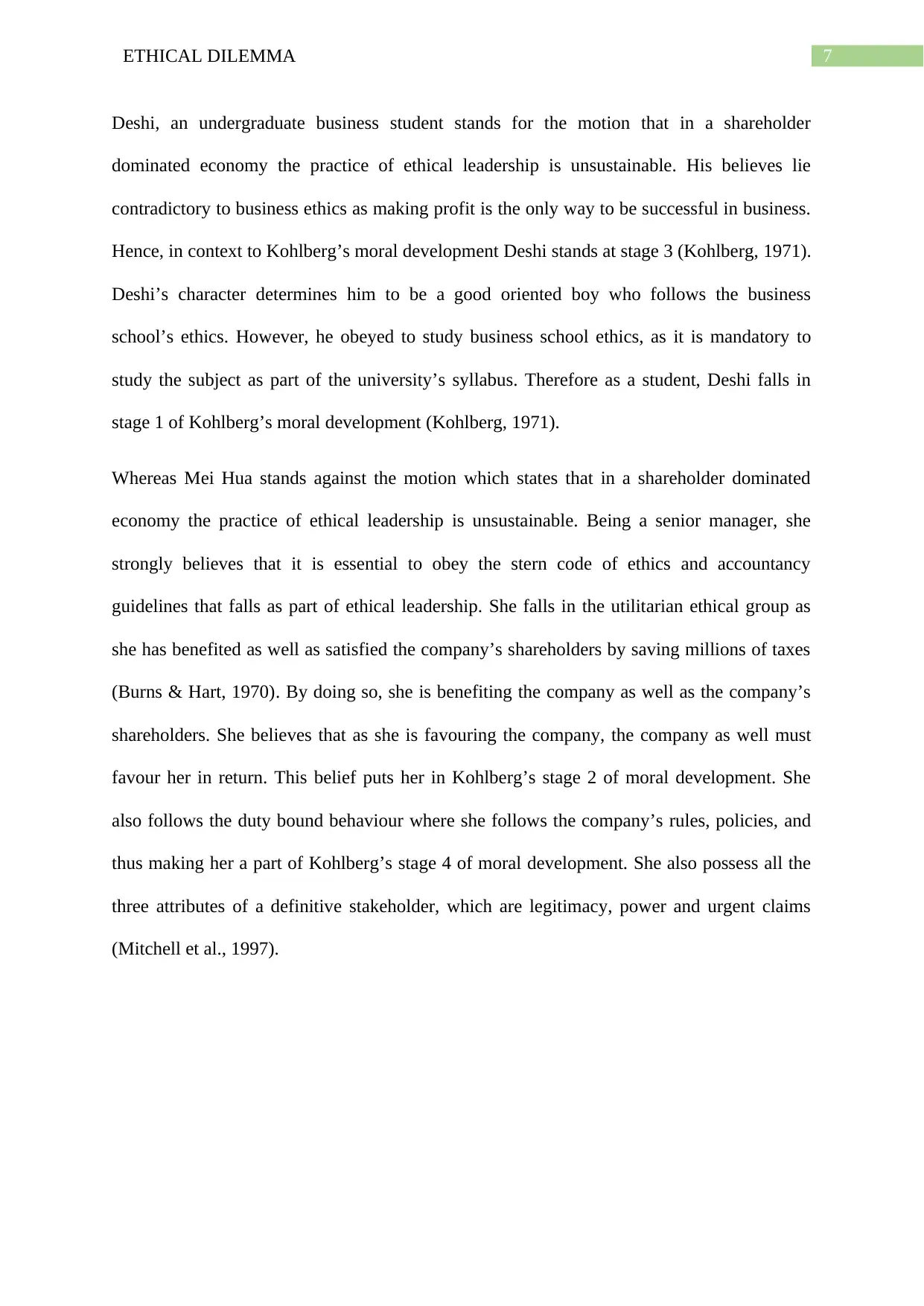
7ETHICAL DILEMMA
Deshi, an undergraduate business student stands for the motion that in a shareholder
dominated economy the practice of ethical leadership is unsustainable. His believes lie
contradictory to business ethics as making profit is the only way to be successful in business.
Hence, in context to Kohlberg’s moral development Deshi stands at stage 3 (Kohlberg, 1971).
Deshi’s character determines him to be a good oriented boy who follows the business
school’s ethics. However, he obeyed to study business school ethics, as it is mandatory to
study the subject as part of the university’s syllabus. Therefore as a student, Deshi falls in
stage 1 of Kohlberg’s moral development (Kohlberg, 1971).
Whereas Mei Hua stands against the motion which states that in a shareholder dominated
economy the practice of ethical leadership is unsustainable. Being a senior manager, she
strongly believes that it is essential to obey the stern code of ethics and accountancy
guidelines that falls as part of ethical leadership. She falls in the utilitarian ethical group as
she has benefited as well as satisfied the company’s shareholders by saving millions of taxes
(Burns & Hart, 1970). By doing so, she is benefiting the company as well as the company’s
shareholders. She believes that as she is favouring the company, the company as well must
favour her in return. This belief puts her in Kohlberg’s stage 2 of moral development. She
also follows the duty bound behaviour where she follows the company’s rules, policies, and
thus making her a part of Kohlberg’s stage 4 of moral development. She also possess all the
three attributes of a definitive stakeholder, which are legitimacy, power and urgent claims
(Mitchell et al., 1997).
Deshi, an undergraduate business student stands for the motion that in a shareholder
dominated economy the practice of ethical leadership is unsustainable. His believes lie
contradictory to business ethics as making profit is the only way to be successful in business.
Hence, in context to Kohlberg’s moral development Deshi stands at stage 3 (Kohlberg, 1971).
Deshi’s character determines him to be a good oriented boy who follows the business
school’s ethics. However, he obeyed to study business school ethics, as it is mandatory to
study the subject as part of the university’s syllabus. Therefore as a student, Deshi falls in
stage 1 of Kohlberg’s moral development (Kohlberg, 1971).
Whereas Mei Hua stands against the motion which states that in a shareholder dominated
economy the practice of ethical leadership is unsustainable. Being a senior manager, she
strongly believes that it is essential to obey the stern code of ethics and accountancy
guidelines that falls as part of ethical leadership. She falls in the utilitarian ethical group as
she has benefited as well as satisfied the company’s shareholders by saving millions of taxes
(Burns & Hart, 1970). By doing so, she is benefiting the company as well as the company’s
shareholders. She believes that as she is favouring the company, the company as well must
favour her in return. This belief puts her in Kohlberg’s stage 2 of moral development. She
also follows the duty bound behaviour where she follows the company’s rules, policies, and
thus making her a part of Kohlberg’s stage 4 of moral development. She also possess all the
three attributes of a definitive stakeholder, which are legitimacy, power and urgent claims
(Mitchell et al., 1997).
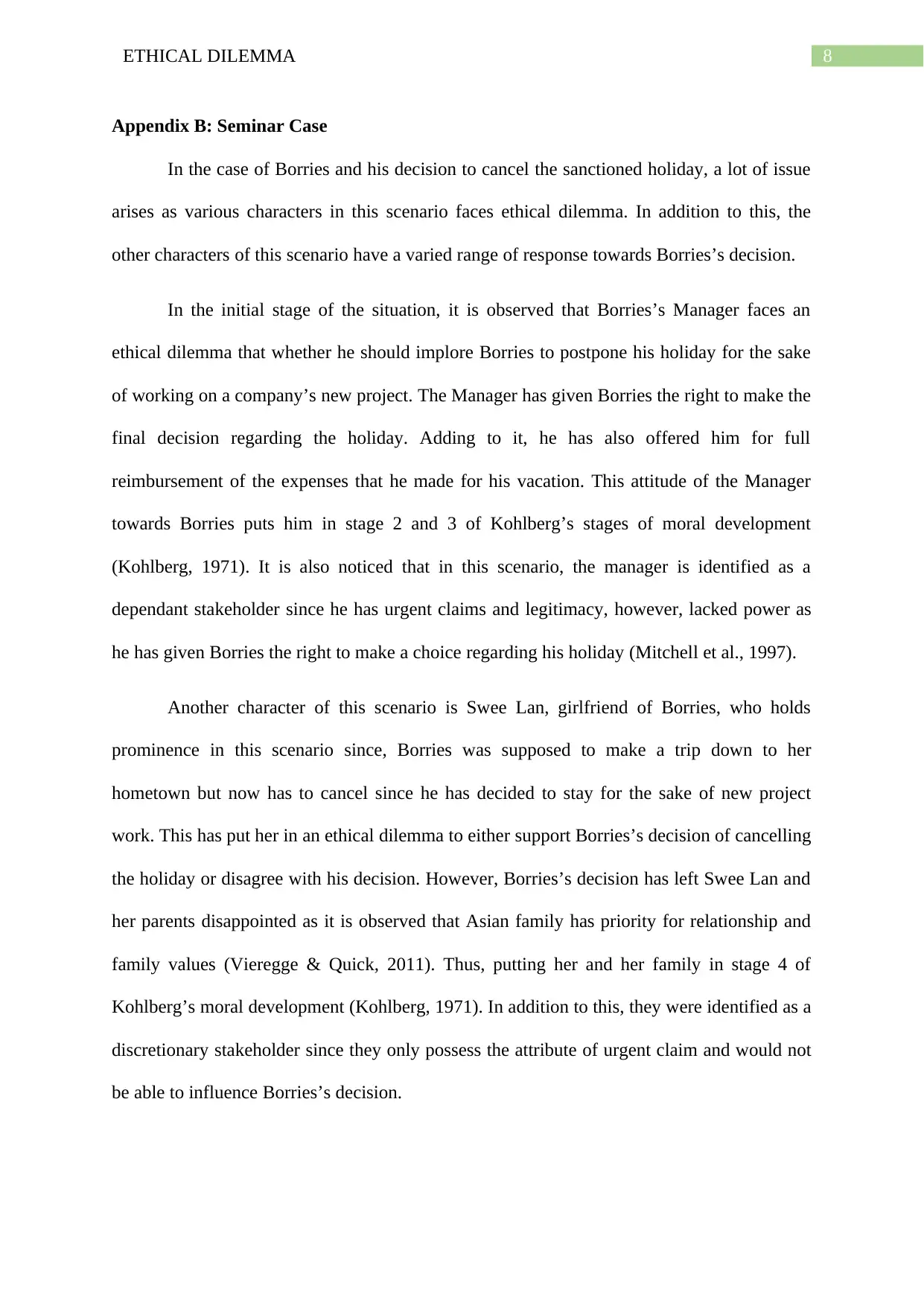
8ETHICAL DILEMMA
Appendix B: Seminar Case
In the case of Borries and his decision to cancel the sanctioned holiday, a lot of issue
arises as various characters in this scenario faces ethical dilemma. In addition to this, the
other characters of this scenario have a varied range of response towards Borries’s decision.
In the initial stage of the situation, it is observed that Borries’s Manager faces an
ethical dilemma that whether he should implore Borries to postpone his holiday for the sake
of working on a company’s new project. The Manager has given Borries the right to make the
final decision regarding the holiday. Adding to it, he has also offered him for full
reimbursement of the expenses that he made for his vacation. This attitude of the Manager
towards Borries puts him in stage 2 and 3 of Kohlberg’s stages of moral development
(Kohlberg, 1971). It is also noticed that in this scenario, the manager is identified as a
dependant stakeholder since he has urgent claims and legitimacy, however, lacked power as
he has given Borries the right to make a choice regarding his holiday (Mitchell et al., 1997).
Another character of this scenario is Swee Lan, girlfriend of Borries, who holds
prominence in this scenario since, Borries was supposed to make a trip down to her
hometown but now has to cancel since he has decided to stay for the sake of new project
work. This has put her in an ethical dilemma to either support Borries’s decision of cancelling
the holiday or disagree with his decision. However, Borries’s decision has left Swee Lan and
her parents disappointed as it is observed that Asian family has priority for relationship and
family values (Vieregge & Quick, 2011). Thus, putting her and her family in stage 4 of
Kohlberg’s moral development (Kohlberg, 1971). In addition to this, they were identified as a
discretionary stakeholder since they only possess the attribute of urgent claim and would not
be able to influence Borries’s decision.
Appendix B: Seminar Case
In the case of Borries and his decision to cancel the sanctioned holiday, a lot of issue
arises as various characters in this scenario faces ethical dilemma. In addition to this, the
other characters of this scenario have a varied range of response towards Borries’s decision.
In the initial stage of the situation, it is observed that Borries’s Manager faces an
ethical dilemma that whether he should implore Borries to postpone his holiday for the sake
of working on a company’s new project. The Manager has given Borries the right to make the
final decision regarding the holiday. Adding to it, he has also offered him for full
reimbursement of the expenses that he made for his vacation. This attitude of the Manager
towards Borries puts him in stage 2 and 3 of Kohlberg’s stages of moral development
(Kohlberg, 1971). It is also noticed that in this scenario, the manager is identified as a
dependant stakeholder since he has urgent claims and legitimacy, however, lacked power as
he has given Borries the right to make a choice regarding his holiday (Mitchell et al., 1997).
Another character of this scenario is Swee Lan, girlfriend of Borries, who holds
prominence in this scenario since, Borries was supposed to make a trip down to her
hometown but now has to cancel since he has decided to stay for the sake of new project
work. This has put her in an ethical dilemma to either support Borries’s decision of cancelling
the holiday or disagree with his decision. However, Borries’s decision has left Swee Lan and
her parents disappointed as it is observed that Asian family has priority for relationship and
family values (Vieregge & Quick, 2011). Thus, putting her and her family in stage 4 of
Kohlberg’s moral development (Kohlberg, 1971). In addition to this, they were identified as a
discretionary stakeholder since they only possess the attribute of urgent claim and would not
be able to influence Borries’s decision.
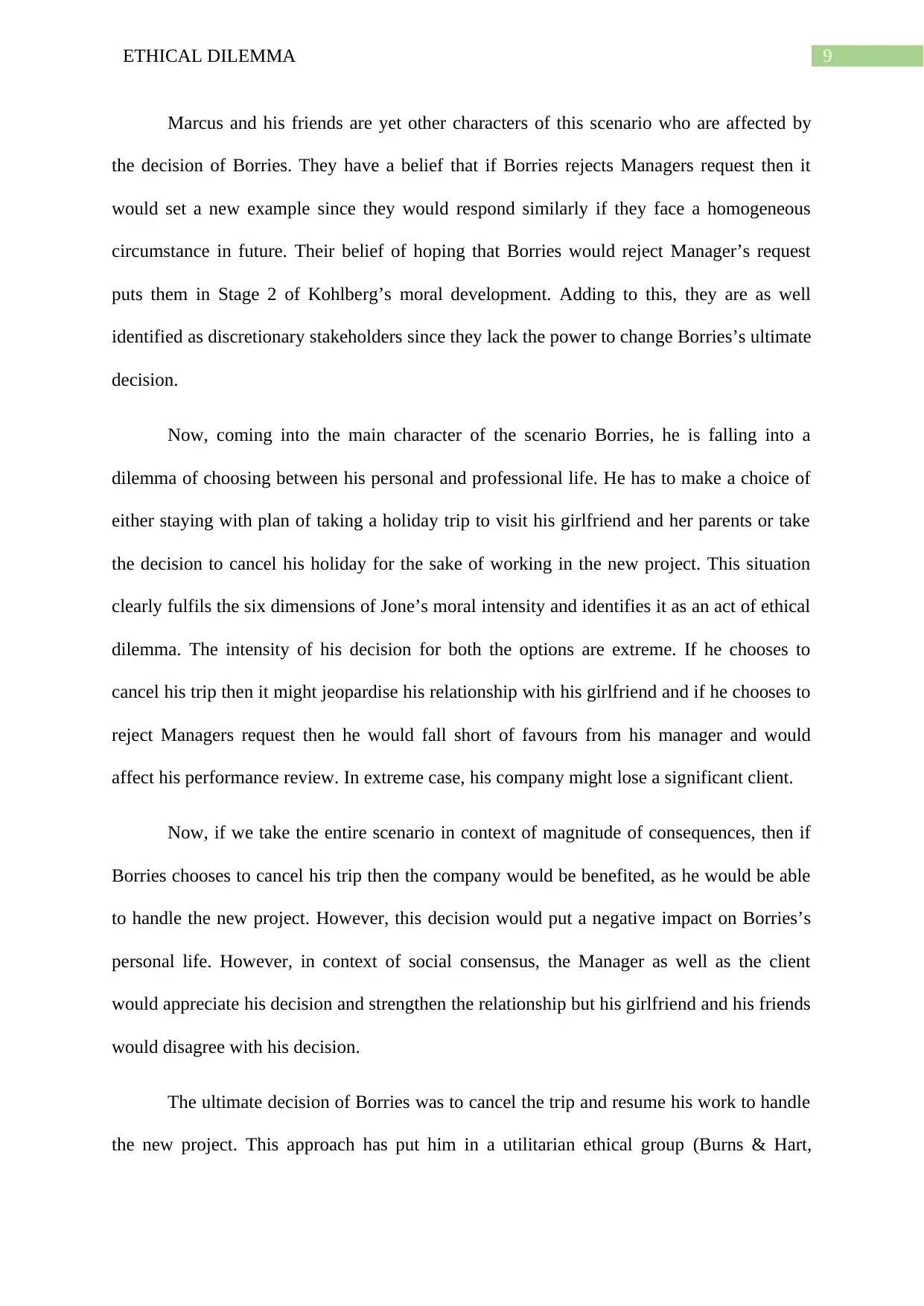
9ETHICAL DILEMMA
Marcus and his friends are yet other characters of this scenario who are affected by
the decision of Borries. They have a belief that if Borries rejects Managers request then it
would set a new example since they would respond similarly if they face a homogeneous
circumstance in future. Their belief of hoping that Borries would reject Manager’s request
puts them in Stage 2 of Kohlberg’s moral development. Adding to this, they are as well
identified as discretionary stakeholders since they lack the power to change Borries’s ultimate
decision.
Now, coming into the main character of the scenario Borries, he is falling into a
dilemma of choosing between his personal and professional life. He has to make a choice of
either staying with plan of taking a holiday trip to visit his girlfriend and her parents or take
the decision to cancel his holiday for the sake of working in the new project. This situation
clearly fulfils the six dimensions of Jone’s moral intensity and identifies it as an act of ethical
dilemma. The intensity of his decision for both the options are extreme. If he chooses to
cancel his trip then it might jeopardise his relationship with his girlfriend and if he chooses to
reject Managers request then he would fall short of favours from his manager and would
affect his performance review. In extreme case, his company might lose a significant client.
Now, if we take the entire scenario in context of magnitude of consequences, then if
Borries chooses to cancel his trip then the company would be benefited, as he would be able
to handle the new project. However, this decision would put a negative impact on Borries’s
personal life. However, in context of social consensus, the Manager as well as the client
would appreciate his decision and strengthen the relationship but his girlfriend and his friends
would disagree with his decision.
The ultimate decision of Borries was to cancel the trip and resume his work to handle
the new project. This approach has put him in a utilitarian ethical group (Burns & Hart,
Marcus and his friends are yet other characters of this scenario who are affected by
the decision of Borries. They have a belief that if Borries rejects Managers request then it
would set a new example since they would respond similarly if they face a homogeneous
circumstance in future. Their belief of hoping that Borries would reject Manager’s request
puts them in Stage 2 of Kohlberg’s moral development. Adding to this, they are as well
identified as discretionary stakeholders since they lack the power to change Borries’s ultimate
decision.
Now, coming into the main character of the scenario Borries, he is falling into a
dilemma of choosing between his personal and professional life. He has to make a choice of
either staying with plan of taking a holiday trip to visit his girlfriend and her parents or take
the decision to cancel his holiday for the sake of working in the new project. This situation
clearly fulfils the six dimensions of Jone’s moral intensity and identifies it as an act of ethical
dilemma. The intensity of his decision for both the options are extreme. If he chooses to
cancel his trip then it might jeopardise his relationship with his girlfriend and if he chooses to
reject Managers request then he would fall short of favours from his manager and would
affect his performance review. In extreme case, his company might lose a significant client.
Now, if we take the entire scenario in context of magnitude of consequences, then if
Borries chooses to cancel his trip then the company would be benefited, as he would be able
to handle the new project. However, this decision would put a negative impact on Borries’s
personal life. However, in context of social consensus, the Manager as well as the client
would appreciate his decision and strengthen the relationship but his girlfriend and his friends
would disagree with his decision.
The ultimate decision of Borries was to cancel the trip and resume his work to handle
the new project. This approach has put him in a utilitarian ethical group (Burns & Hart,
Secure Best Marks with AI Grader
Need help grading? Try our AI Grader for instant feedback on your assignments.
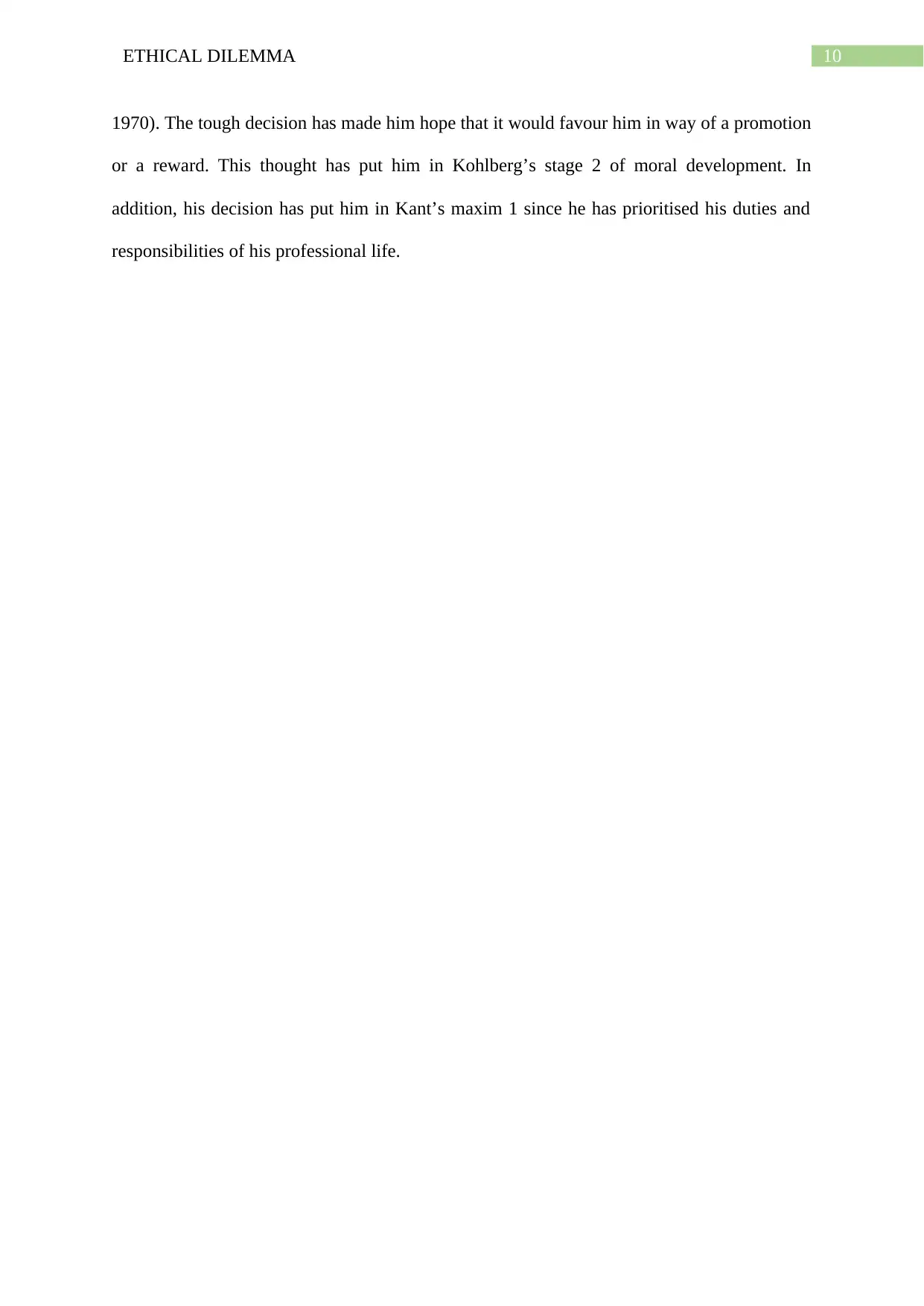
10ETHICAL DILEMMA
1970). The tough decision has made him hope that it would favour him in way of a promotion
or a reward. This thought has put him in Kohlberg’s stage 2 of moral development. In
addition, his decision has put him in Kant’s maxim 1 since he has prioritised his duties and
responsibilities of his professional life.
1970). The tough decision has made him hope that it would favour him in way of a promotion
or a reward. This thought has put him in Kohlberg’s stage 2 of moral development. In
addition, his decision has put him in Kant’s maxim 1 since he has prioritised his duties and
responsibilities of his professional life.
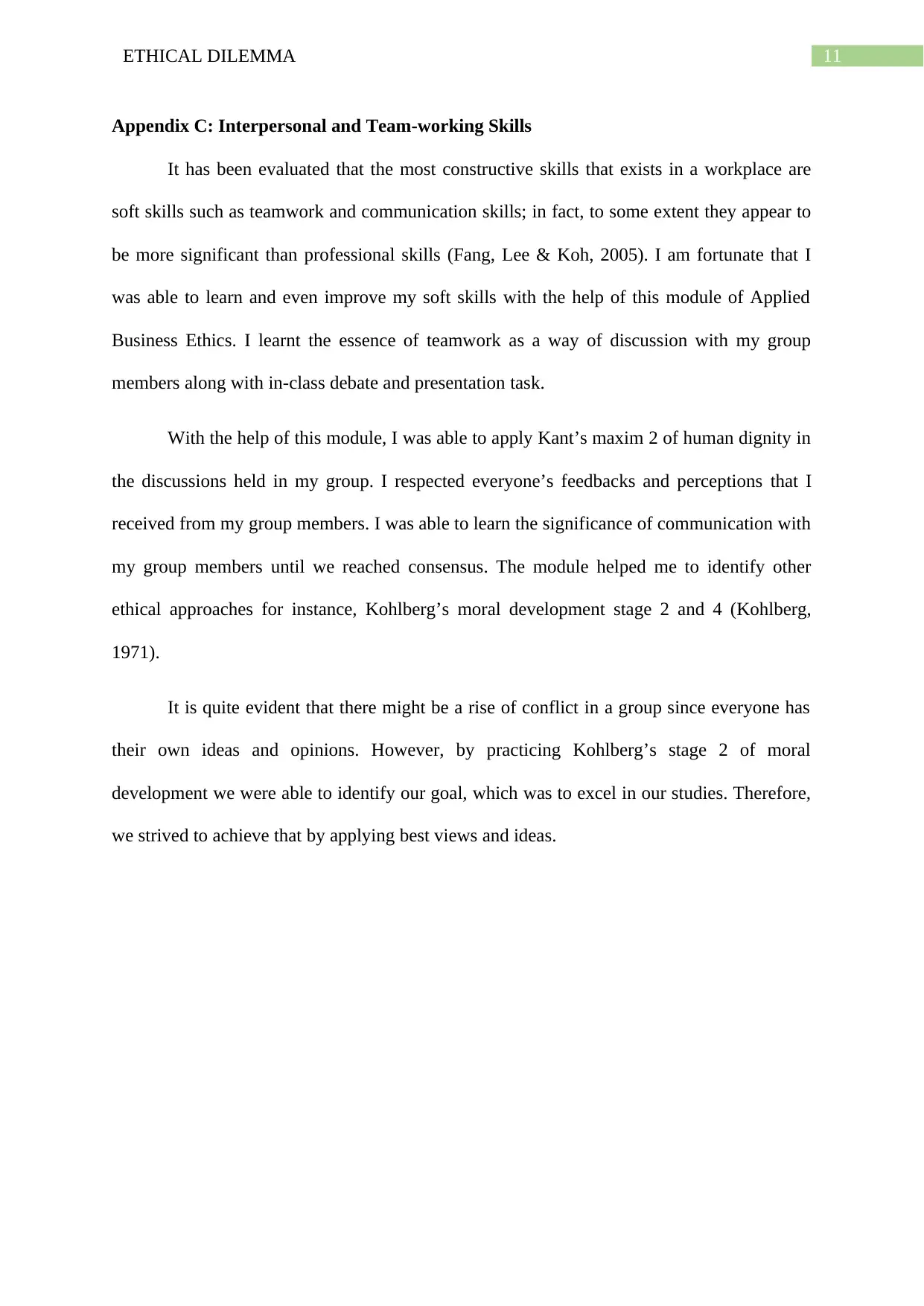
11ETHICAL DILEMMA
Appendix C: Interpersonal and Team-working Skills
It has been evaluated that the most constructive skills that exists in a workplace are
soft skills such as teamwork and communication skills; in fact, to some extent they appear to
be more significant than professional skills (Fang, Lee & Koh, 2005). I am fortunate that I
was able to learn and even improve my soft skills with the help of this module of Applied
Business Ethics. I learnt the essence of teamwork as a way of discussion with my group
members along with in-class debate and presentation task.
With the help of this module, I was able to apply Kant’s maxim 2 of human dignity in
the discussions held in my group. I respected everyone’s feedbacks and perceptions that I
received from my group members. I was able to learn the significance of communication with
my group members until we reached consensus. The module helped me to identify other
ethical approaches for instance, Kohlberg’s moral development stage 2 and 4 (Kohlberg,
1971).
It is quite evident that there might be a rise of conflict in a group since everyone has
their own ideas and opinions. However, by practicing Kohlberg’s stage 2 of moral
development we were able to identify our goal, which was to excel in our studies. Therefore,
we strived to achieve that by applying best views and ideas.
Appendix C: Interpersonal and Team-working Skills
It has been evaluated that the most constructive skills that exists in a workplace are
soft skills such as teamwork and communication skills; in fact, to some extent they appear to
be more significant than professional skills (Fang, Lee & Koh, 2005). I am fortunate that I
was able to learn and even improve my soft skills with the help of this module of Applied
Business Ethics. I learnt the essence of teamwork as a way of discussion with my group
members along with in-class debate and presentation task.
With the help of this module, I was able to apply Kant’s maxim 2 of human dignity in
the discussions held in my group. I respected everyone’s feedbacks and perceptions that I
received from my group members. I was able to learn the significance of communication with
my group members until we reached consensus. The module helped me to identify other
ethical approaches for instance, Kohlberg’s moral development stage 2 and 4 (Kohlberg,
1971).
It is quite evident that there might be a rise of conflict in a group since everyone has
their own ideas and opinions. However, by practicing Kohlberg’s stage 2 of moral
development we were able to identify our goal, which was to excel in our studies. Therefore,
we strived to achieve that by applying best views and ideas.
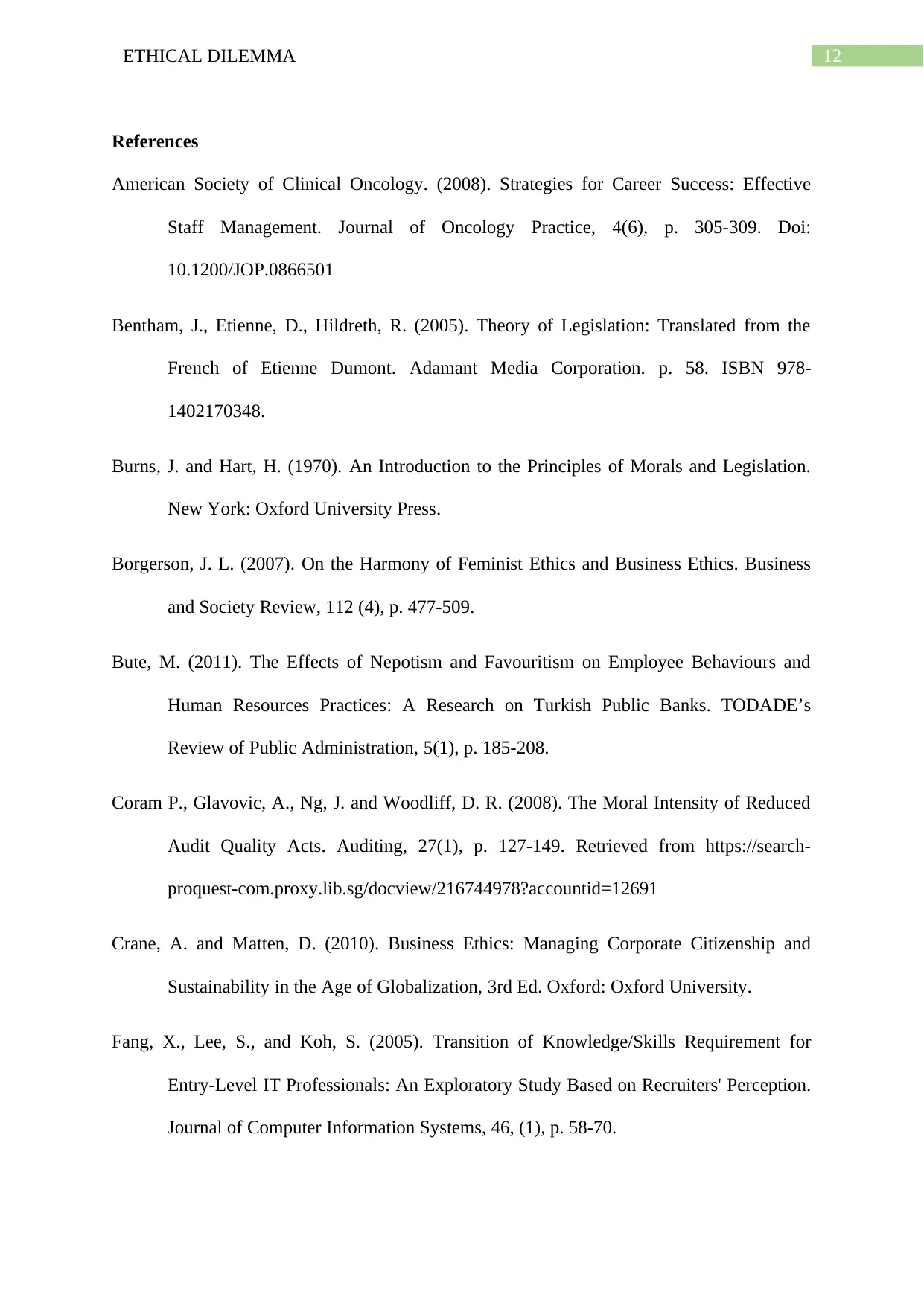
12ETHICAL DILEMMA
References
American Society of Clinical Oncology. (2008). Strategies for Career Success: Effective
Staff Management. Journal of Oncology Practice, 4(6), p. 305-309. Doi:
10.1200/JOP.0866501
Bentham, J., Etienne, D., Hildreth, R. (2005). Theory of Legislation: Translated from the
French of Etienne Dumont. Adamant Media Corporation. p. 58. ISBN 978-
1402170348.
Burns, J. and Hart, H. (1970). An Introduction to the Principles of Morals and Legislation.
New York: Oxford University Press.
Borgerson, J. L. (2007). On the Harmony of Feminist Ethics and Business Ethics. Business
and Society Review, 112 (4), p. 477-509.
Bute, M. (2011). The Effects of Nepotism and Favouritism on Employee Behaviours and
Human Resources Practices: A Research on Turkish Public Banks. TODADE’s
Review of Public Administration, 5(1), p. 185-208.
Coram P., Glavovic, A., Ng, J. and Woodliff, D. R. (2008). The Moral Intensity of Reduced
Audit Quality Acts. Auditing, 27(1), p. 127-149. Retrieved from https://search-
proquest-com.proxy.lib.sg/docview/216744978?accountid=12691
Crane, A. and Matten, D. (2010). Business Ethics: Managing Corporate Citizenship and
Sustainability in the Age of Globalization, 3rd Ed. Oxford: Oxford University.
Fang, X., Lee, S., and Koh, S. (2005). Transition of Knowledge/Skills Requirement for
Entry-Level IT Professionals: An Exploratory Study Based on Recruiters' Perception.
Journal of Computer Information Systems, 46, (1), p. 58-70.
References
American Society of Clinical Oncology. (2008). Strategies for Career Success: Effective
Staff Management. Journal of Oncology Practice, 4(6), p. 305-309. Doi:
10.1200/JOP.0866501
Bentham, J., Etienne, D., Hildreth, R. (2005). Theory of Legislation: Translated from the
French of Etienne Dumont. Adamant Media Corporation. p. 58. ISBN 978-
1402170348.
Burns, J. and Hart, H. (1970). An Introduction to the Principles of Morals and Legislation.
New York: Oxford University Press.
Borgerson, J. L. (2007). On the Harmony of Feminist Ethics and Business Ethics. Business
and Society Review, 112 (4), p. 477-509.
Bute, M. (2011). The Effects of Nepotism and Favouritism on Employee Behaviours and
Human Resources Practices: A Research on Turkish Public Banks. TODADE’s
Review of Public Administration, 5(1), p. 185-208.
Coram P., Glavovic, A., Ng, J. and Woodliff, D. R. (2008). The Moral Intensity of Reduced
Audit Quality Acts. Auditing, 27(1), p. 127-149. Retrieved from https://search-
proquest-com.proxy.lib.sg/docview/216744978?accountid=12691
Crane, A. and Matten, D. (2010). Business Ethics: Managing Corporate Citizenship and
Sustainability in the Age of Globalization, 3rd Ed. Oxford: Oxford University.
Fang, X., Lee, S., and Koh, S. (2005). Transition of Knowledge/Skills Requirement for
Entry-Level IT Professionals: An Exploratory Study Based on Recruiters' Perception.
Journal of Computer Information Systems, 46, (1), p. 58-70.
Paraphrase This Document
Need a fresh take? Get an instant paraphrase of this document with our AI Paraphraser
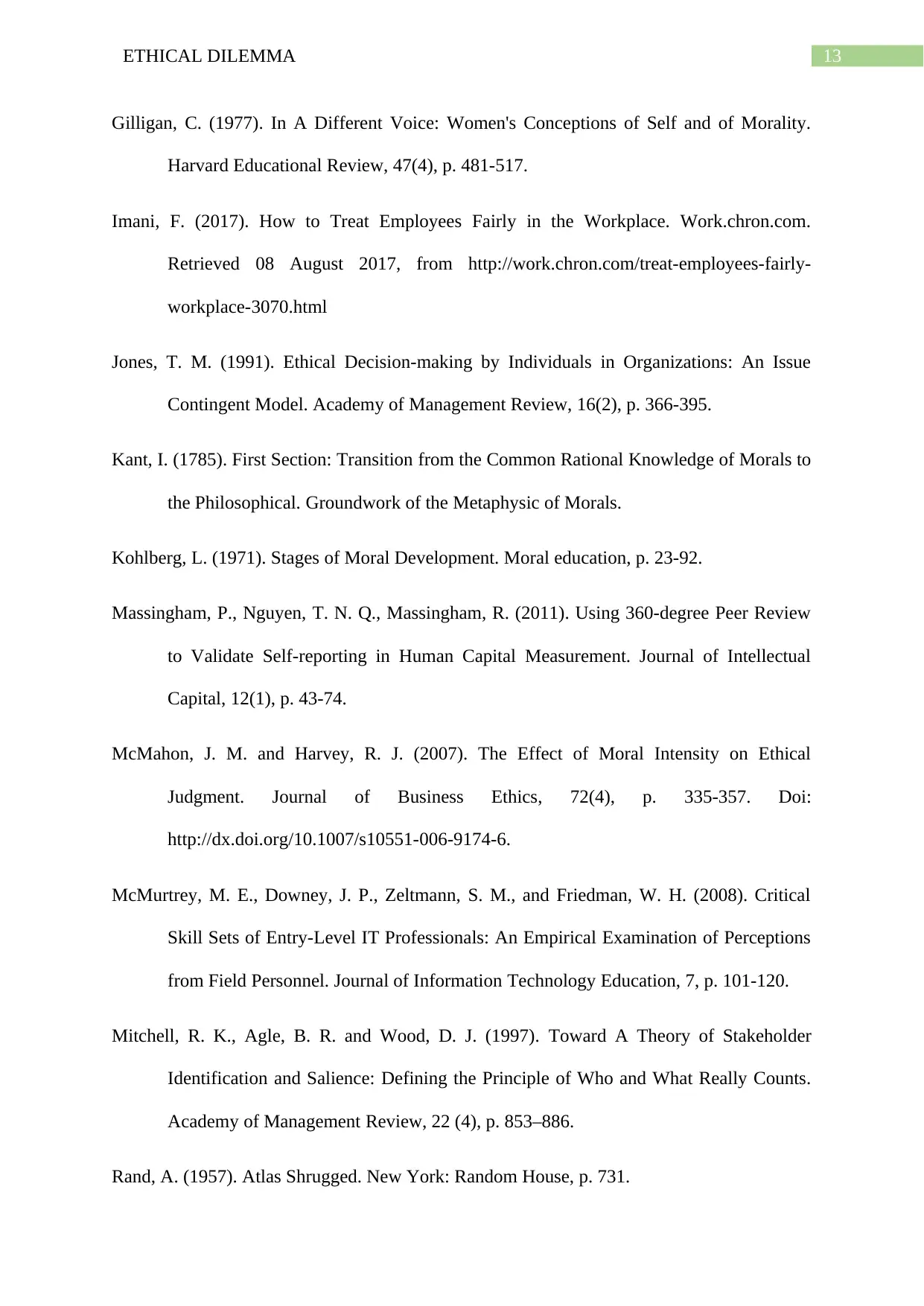
13ETHICAL DILEMMA
Gilligan, C. (1977). In A Different Voice: Women's Conceptions of Self and of Morality.
Harvard Educational Review, 47(4), p. 481-517.
Imani, F. (2017). How to Treat Employees Fairly in the Workplace. Work.chron.com.
Retrieved 08 August 2017, from http://work.chron.com/treat-employees-fairly-
workplace-3070.html
Jones, T. M. (1991). Ethical Decision-making by Individuals in Organizations: An Issue
Contingent Model. Academy of Management Review, 16(2), p. 366-395.
Kant, I. (1785). First Section: Transition from the Common Rational Knowledge of Morals to
the Philosophical. Groundwork of the Metaphysic of Morals.
Kohlberg, L. (1971). Stages of Moral Development. Moral education, p. 23-92.
Massingham, P., Nguyen, T. N. Q., Massingham, R. (2011). Using 360-degree Peer Review
to Validate Self-reporting in Human Capital Measurement. Journal of Intellectual
Capital, 12(1), p. 43-74.
McMahon, J. M. and Harvey, R. J. (2007). The Effect of Moral Intensity on Ethical
Judgment. Journal of Business Ethics, 72(4), p. 335-357. Doi:
http://dx.doi.org/10.1007/s10551-006-9174-6.
McMurtrey, M. E., Downey, J. P., Zeltmann, S. M., and Friedman, W. H. (2008). Critical
Skill Sets of Entry-Level IT Professionals: An Empirical Examination of Perceptions
from Field Personnel. Journal of Information Technology Education, 7, p. 101-120.
Mitchell, R. K., Agle, B. R. and Wood, D. J. (1997). Toward A Theory of Stakeholder
Identification and Salience: Defining the Principle of Who and What Really Counts.
Academy of Management Review, 22 (4), p. 853–886.
Rand, A. (1957). Atlas Shrugged. New York: Random House, p. 731.
Gilligan, C. (1977). In A Different Voice: Women's Conceptions of Self and of Morality.
Harvard Educational Review, 47(4), p. 481-517.
Imani, F. (2017). How to Treat Employees Fairly in the Workplace. Work.chron.com.
Retrieved 08 August 2017, from http://work.chron.com/treat-employees-fairly-
workplace-3070.html
Jones, T. M. (1991). Ethical Decision-making by Individuals in Organizations: An Issue
Contingent Model. Academy of Management Review, 16(2), p. 366-395.
Kant, I. (1785). First Section: Transition from the Common Rational Knowledge of Morals to
the Philosophical. Groundwork of the Metaphysic of Morals.
Kohlberg, L. (1971). Stages of Moral Development. Moral education, p. 23-92.
Massingham, P., Nguyen, T. N. Q., Massingham, R. (2011). Using 360-degree Peer Review
to Validate Self-reporting in Human Capital Measurement. Journal of Intellectual
Capital, 12(1), p. 43-74.
McMahon, J. M. and Harvey, R. J. (2007). The Effect of Moral Intensity on Ethical
Judgment. Journal of Business Ethics, 72(4), p. 335-357. Doi:
http://dx.doi.org/10.1007/s10551-006-9174-6.
McMurtrey, M. E., Downey, J. P., Zeltmann, S. M., and Friedman, W. H. (2008). Critical
Skill Sets of Entry-Level IT Professionals: An Empirical Examination of Perceptions
from Field Personnel. Journal of Information Technology Education, 7, p. 101-120.
Mitchell, R. K., Agle, B. R. and Wood, D. J. (1997). Toward A Theory of Stakeholder
Identification and Salience: Defining the Principle of Who and What Really Counts.
Academy of Management Review, 22 (4), p. 853–886.
Rand, A. (1957). Atlas Shrugged. New York: Random House, p. 731.

14ETHICAL DILEMMA
Stuebs, M. and Sun, L. (2015). Corporate Governance and Social Responsibility.
International Journal of Law and Management, 57(1), p. 38-52. Retrieved from
https://search-proquest-com.proxy.lib.sg/docview/1648568055?accountid=12691
Trevino, L. K. (1986). Ethical Decision Making in Organizations: A Person-Situation
Interactionist Model. Academy of Management Review, 11, p. 601-617.
Van, H. J. and Greenwood, M. (2011). Bringing Stakeholder Theory to Industrial Relations.
Employee Relations, 33(1), p. 5-21. Doi:
http://dx.doi.org/10.1108/01425451111091627
Vieregge, M., and Quick, S. (2011). Cross-cultural Negotiations Revisited. Cross Cultural
Management, 18(3), p. 313-326. Doi: http://dx.doi.org/10.1108/13527601111152842
Stuebs, M. and Sun, L. (2015). Corporate Governance and Social Responsibility.
International Journal of Law and Management, 57(1), p. 38-52. Retrieved from
https://search-proquest-com.proxy.lib.sg/docview/1648568055?accountid=12691
Trevino, L. K. (1986). Ethical Decision Making in Organizations: A Person-Situation
Interactionist Model. Academy of Management Review, 11, p. 601-617.
Van, H. J. and Greenwood, M. (2011). Bringing Stakeholder Theory to Industrial Relations.
Employee Relations, 33(1), p. 5-21. Doi:
http://dx.doi.org/10.1108/01425451111091627
Vieregge, M., and Quick, S. (2011). Cross-cultural Negotiations Revisited. Cross Cultural
Management, 18(3), p. 313-326. Doi: http://dx.doi.org/10.1108/13527601111152842
1 out of 15
Your All-in-One AI-Powered Toolkit for Academic Success.
+13062052269
info@desklib.com
Available 24*7 on WhatsApp / Email
![[object Object]](/_next/static/media/star-bottom.7253800d.svg)
Unlock your academic potential
© 2024 | Zucol Services PVT LTD | All rights reserved.